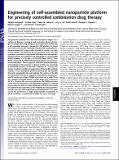Engineering of self-assembled nanoparticle platform for precisely controlled combination drug therapy
Author(s)
Kolishetti, Nagesh; Dhar, Shanta; Valencia, Pedro Miguel; Lin, Lucy Q.; Karnik, Rohit; Lippard, Stephen J.; Langer, Robert; Farokhzad, Omid C.; ... Show more Show less
DownloadPNAS-2010-Kolishetti-17939-44.pdf (1.035Mb)
PUBLISHER_POLICY
Publisher Policy
Article is made available in accordance with the publisher's policy and may be subject to US copyright law. Please refer to the publisher's site for terms of use.
Terms of use
Metadata
Show full item recordAbstract
The genomic revolution has identified therapeutic targets for a plethora of diseases, creating a need to develop robust technologies for combination drug therapy. In the present work, we describe a self-assembled polymeric nanoparticle (NP) platform to target and control precisely the codelivery of drugs with varying physicochemical properties to cancer cells. As proof of concept, we codelivered cisplatin and docetaxel (Dtxl) to prostate cancer cells with synergistic cytotoxicity. A polylactide (PLA) derivative with pendant hydroxyl groups was prepared and conjugated to a platinum(IV) [Pt(IV)] prodrug, c,t,c-[Pt(NH[subscript 3])[subscript 2](O[subscript 2]CCH[subscript 2]CH[subscript 2]COOH)(OH)Cl[subscript 2]] [PLA-Pt(IV)]. A blend of PLA-Pt(IV) functionalized polymer and carboxyl-terminated poly(d,l-lactic-co-glycolic acid)-block-poly(ethylene glycol) copolymer in the presence or absence of Dtxl, was converted, in microfluidic channels, to NPs with a diameter of ∼100 nm. This process resulted in excellent encapsulation efficiency (EE) and high loading of both hydrophilic platinum prodrug and hydrophobic Dtxl with reproducible EEs and loadings. The surface of the NPs was derivatized with the A10 aptamer, which binds to the prostate-specific membrane antigen (PSMA) on prostate cancer cells. These NPs undergo controlled release of both drugs over a period of 48–72 h. Targeted NPs were internalized by the PSMA-expressing LNCaP cells via endocytosis, and formation of cisplatin 1,2-d(GpG) intrastrand cross-links on nuclear DNA was verified. In vitro toxicities demonstrated superiority of the targeted dual-drug combination NPs over NPs with single drug or nontargeted NPs. This work reveals the potential of a single, programmable nanoparticle to blend and deliver a combination of drugs for cancer treatment.
Date issued
2010-10Department
MIT-Harvard Center for Cancer Nanotechnology Excellence; Massachusetts Institute of Technology. Institute for Medical Engineering & Science; Massachusetts Institute of Technology. Department of Chemical Engineering; Massachusetts Institute of Technology. Department of Chemistry; Massachusetts Institute of Technology. Department of Mechanical Engineering; Koch Institute for Integrative Cancer Research at MITJournal
Proceedings of the National Academy of Sciences of the United States of America
Publisher
National Academy of Sciences (U.S.)
Citation
Kolishetti, N., S. Dhar, P. M. Valencia, et al. Engineering of Self-assembled Nanoparticle Platform for Precisely Controlled Combination Drug Therapy. Proceedings of the National Academy of Sciences 107(42): 17939–17944, 2010.
Version: Final published version
ISSN
0027-8424
1091-6490